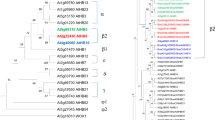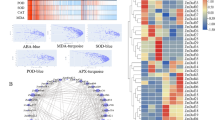Abstract
AtMYB30 is well known as a transcription factor involved in cell death processes during the hypersensitive response against biotic stress in Arabidopsis thaliana. Despite the relevant function played by R2R3-MYB transcription factors in the regulation of plant gene expression, limited information exists about how these proteins interact with their DNA targets, their specificity, and binding affinity. Our findings confirm the binding of a specific DNA sequence (5′-AAACCAA) to AtMYB30, binding affinities were calculated, and the effect of DNA on AtMYB30 secondary structure was evaluated. Our data shed new light on the interaction between DNA and this important member of a plant-specific transcriptional regulator family.




Similar content being viewed by others
Abbreviations
- CD:
-
Circular dichroism
- DBD:
-
DNA-binding domain
- EDTA:
-
Ethylenediaminetetraaceticacid
- EMSA:
-
Electrophoretic mobility shift assay
- EtOH:
-
Ethanol
- HTH:
-
Helix-turn-helix
- ITC:
-
Isothermal titration calorimetry
- KD :
-
Equilibrium dissociation constant
- NO:
-
Nitric oxide
- PAGE:
-
Polyacrylamide gel electrophoresis
References
Barozzi I, Bora P, Morelli MJ (2014) Comparative evaluation of DNase-seq footprint identification strategies. Front Genet. 5, 278. eCollection 2014. doi:10.3389/fgene.2014.00278
Brendeford EM, Myrset AH, Hegvold AB, Lundin M, Gabrielsen OS (1997) Oncogenic point mutations induce altered conformation, redox sensitivity, and DNA binding in the minimal DNA binding domain of avian myeloblastosis virus v-Myb. J Biol Chem 272(7):4436–4443. doi:10.1074/jbc.272.7.4436
Brendeford EM, Andersson KB, Gabrielsen OS (1998) Nitric oxide (NO) disrupts specific DNA binding of the transcription factor c-Myb in vitro. FEBS Lett 425:52–56. doi:10.1016/S0014-5793(98)00196-3
Dexheimer TS, Pommier Y (2008) DNA cleavage assay for the identification of topoisomerase I inhibitors. Nat Protoc 3(11):1736–1750. doi:10.1038/nprot.2008.174
Favicchio R, Dragan AI, Kneale GG, Christopher M (2014) Fluorescence spectroscopy and anisotropy in the analysis of DNA–protein interactions. Read Spectrochim Acta A Mol Biomol Spectrosc 121:23–34. doi:10.1007/978-1-60327-015-1_35
Feldbrügge M, Sprenger M, Hahlbrock K, Weisshaar B (1997) PcMYB1, a novel plant protein containing a DNA-binding domain with one MYB repeat, interacts in vivo with a light-regulatory promoter unit. Plant J 11:1079–1093. doi:10.1046/j.1365-313X.1997.11051079.x
Gabrielsen OS, Sentenac A, Fromageot P (1991) Specific DNA binding by c-Myb: evidence for a double helix-turn-helix-related motif. Science 253:1140–1143. doi:10.1126/science.1887237
Hengen PN (1996) Methods and reagents – carriers for precipitating nucleic acids. TIBS 21:224–225
Inoue T, Shoji W, Obinata M (2000) MIDA1 is a sequence specific DNA binding protein with novel DNA binding properties. Genes Cells 5:699–709. doi:10.1046/j.1365-2443.2000.00362.x
König P, Fairall L, Rhodes D (1998) Sequence-specific DNA recognition by the myb-like domain of the human telomere binding protein TRF1: a model for the protein-DNA complex. Nucleic Acids Res 26(7):1731–1740. doi:10.1093/nar/26.7.1731
Kulkarni R, Feng JY, Miller MD, White KL (2013) Dead-end complexes contribute to the synergistic inhibition of HIV-1 RT by the combination of rilpivirine, emtricitabine, and tenofovir. Antiviral Res 101:131–135. doi:10.1016/j.antiviral.2013.11.010
Li L, Yu X, Thompson A, Guo M, Yoshida S, Asami T, Chory J, Yin Y (2009) Arabidopsis MYB30 is direct target of BES1 and cooperates with BES1 to regulate brassinosteroid-induced gene expression. Plant J 58:275–286. doi:10.1111/j.1365-313X.2008.03778.x
Madan A, Hosur RV, Padhy LC (1994) Sequence-specific DNA displaces 6-p-toluidino-2-naphthalenesulfonate bound to a hydrophobic site on the DNA-binding domain of Drosophila c-myb. Biochemistry 14:7120–7126. doi:10.1021/bi00189a015
McIntosh PB, Frenkiel TA, Wollborn U, McCormick JE, Klempnauer KH, Feeney J, Carr MD (1998) Solution structure of the B-Myb DNA-binding domain: a possible role for conformational instability of the protein in DNA binding and control of gene expression. Biochemistry 37(27):9619–9629. doi:10.1021/bi972861z
Morii H, Uedaira H, Ogata K, Ishii S, Sarai A (1999) Shape and energetics of a cavity in c-Myb probed by natural and non-natural amino acid mutations. J Mol Biol 292(4):909–920. doi:10.1006/jmbi.1999.3099
Ording E, Kvåvik W, Bostad A, Gabrielsen OS (1994) Two functionally distinct half sites in the DNA-recognition sequence of the Myb oncoprotein. Eur J Biochem 222:113–120. doi:10.1111/j.1432-1033.1994.tb18848.x
Powers JP, Rozek A, Hancock RE (2004) Structure-activity relationships for the beta-hairpin cationic antimicrobial peptide polyphemusin I. Biochim Biophys Acta 1698:239–250. doi:10.1016/j.bbapap.2003.12.009
Prouse MB, Campbell MM (2012) The interaction between MYB proteins and their target DNA binding sites. Biochim Biophys Acta 1819:67–77. doi:10.1016/j.bbagrm.2011.10.010
Prouse MB, Campbell MM (2013) Interactions between the R2R3-MYB transcription factor, AtMYB61, and target DNA binding sites. PLoS One. 3: Print 2013. doi:10.1371/journal.pone.0065132.
Samanta A, Jana S, Ray D, Guchhait N (2014) Modulated photophysics of a cationic DNA-staining dye inside protein bovine serum albumin: study of binding interaction and structural changes of protein. Spectrochim Acta A Mol Biomol Spectrosc 121:23–34. doi:10.1016/j.saa.2013.10.049
Shi X, Nishimura Y, Akashi S, Takamizawa A, Hiraoka K (2006) Evaluation of binding affinity of protein-mutant DNA complexes in solution by laser spray mass spectrometry. J Am Soc Mass Spectrom 17(4):611–620. doi:10.1016/j.jasms.2005.12.016
Tahmaseb K, Turchi JJ (2010) Intrinsic hTRF1 fluorescence quenching reveals details of telomere DNA binding activity: impact of DNA length, structure and position of telomeric repeats. Arch Biochem Biophys 15:207–212. doi:10.1016/j.abb.2009.10.015
Tavares CP, Vernal J, Delena RA, Lamattina L, Cassia R, Terenzi H (2014) S-nitrosylation influences the structure and DNA binding activity of AtMYB30 transcription factor from Arabidopsis thaliana. Biochim Biophys Acta 1844(4):810–817. doi:10.1016/j.bbapap.2014.02.015
Vacha P, Zuskova I, Bumba L, Herman P, Vecer J, Obsilova V, Obsil T (2013) Detailed kinetic analysis of the interaction between the FOXO4-DNA-binding domain and DNA. Biophys Chem 184:68–78. doi:10.1016/j.bpc.2013.09.002
Vailleau F, Daniel X, Tronchet M, Montillet JL, Triantaphylidès C, Roby DA (2002) R2R3-MYB gene, AtMYB30, acts as a positive regulator of the hypersensitive cell death program in plants in response to pathogen attack. Plant Biol 99:10179–10184. doi:10.1073/pnas.152047199
Wang H, Guan S, Zhu Z, Wang Y, Lu Y (2013) A valid strategy for precise identifications of transcription factor binding sites in combinatorial regulation using bioinformatic and experimental approaches. Plant Methods 24:34. doi:10.1186/1746-4811-9-34
Yang SW et al (2003) Expression of the telomeric repeat binding factor gene NgTRF1 is closely coordinated with the cell division program in tobacco BY-2 suspension culture cells. J Biol Chem 278(24):21395–21407. doi:10.1074/jbc.M209973200
Zargarian L, Le Tilly V, Jamin N, Chaffotte A, Gabrielsen OS, Toma F, Alpert B (1999) Myb-DNA recognition: role of tryptophan residues and structural changes of the minimal DNA binding domain of c-Myb. Biochemistry 38(6):1921–1929. doi:10.1021/bi981199j
Zheng Y, Schumaker KS, Guo Y (2012) Sumoylation of transcription factor MYB30 by the small ubiquitin-like modifier E3 ligase SIZ1 mediates abscisic acid response in Arabidopsis thaliana. Proc Natl Acad Sci U S A 31:109–131. doi:10.1073/pnas.1202630109
Zobel A, Kalkbrenner F, Guehmann S, Nawrath M, Vorbrueggen G, Moelling K (1991) Interaction of the v-and c-Myb proteins with regulatory sequences of the human c-myc gene. Oncogene 6:1397–1407
Acknowledgments
This work was supported by Conselho Nacional de Desenvolvimento Científico e Tecnológico (CNPq), Coordenação de Aperfeiçoamento de Pessoal de Nível Superior (CAPES), Fundação de Amparo à Pesquisa Científica de Tecnológica do Estado de Santa Catarina (FAPESC), Financiadora de Estudos e Projetos (FINEP), and Instituto Nacional de Biologia Estrutural e Bioimagem (INBEB). We acknowledge the technical staff of CEBIME for assistance.
Author information
Authors and Affiliations
Corresponding author
Rights and permissions
About this article
Cite this article
Tavares, C.P., Terenzi, H. Biochemical analysis of the interaction between Arabidopsis thaliana AtMYB30 transcription factor and its DNA specific target site. J. Plant Biochem. Biotechnol. 25, 97–103 (2016). https://doi.org/10.1007/s13562-015-0315-9
Received:
Accepted:
Published:
Issue Date:
DOI: https://doi.org/10.1007/s13562-015-0315-9




